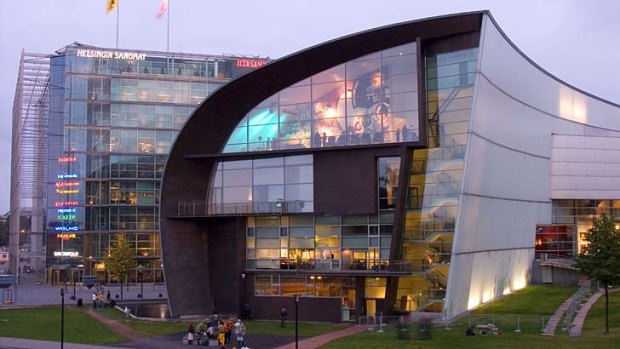
Hot as Helsinki ... the Finnish city is dotted with arresting architecture.Credit: Alamy
David Nicholls is inspired by the landmark buildings and events that cement Helsinki's position as a world design hub.
Like their Scandinavian neighbours, the Finns take design very seriously, and there is no better place to witness this aesthetic than in Helsinki, celebrating its role as this year's World Design Capital. A fascinating program of exhibitions and events is focused on the Design Museum and the Museum of Finnish Architecture, both in the Design District of the city.
Here is a guide to some of the key new and historic buildings and design attractions in the capital.
World Design Capital Pavilion
This temporary structure has popped up in the heart of Helsinki's Design District. Erected between the Design Museum and the Museum of Finnish Architecture, it is a fairly open structure, designed by a student at Aalto University's Wood Program, and is a showcase of Finnish sustainable wood architecture. It has a good cafe, a DJ booth and a program of exhibitions, design-related talks and daily activities.
Design District
Dozens of independent design and fashion boutiques, galleries and cafes make this area worth at least a full afternoon's exploration. Design Forum Finland (designforum.fi) is one of the best places to pick up Finnish creations. Next door is Laboratory, an excellent pop-up photographic gallery run by a local photo agency, Viewmasters.
Nearby are men's and women's branches of My O My (myomy.fi), each selling clothes by Nordic designers, including Saara Lepokorpi and Henrik Vibskov.
Cafe Bar 9, a bohemian eatery and watering hole, is the ideal place to refuel.
Alvar Aalto's house
The architect Alvar Aalto (1898-1976) is a major figure in Finland's design heritage and is considered a national hero. A key proponent of the modernist movement, he is responsible for about 15 buildings and landmarks in Helsinki, and you can easily spend a day doing your own "Aalto tour".
Key to this is the home he designed and built for himself in Munkkiniemi, a smart residential area in the west of the city. There is no better place to gain an understanding of how Aalto envisaged modernist living, and to appreciate the enduring appeal of the style (www.alvaraalto.fi).
Chapel of Silence
A strange, egg-shaped structure has been taking shape outside the Kamppi shopping centre in central Helsinki. This is the Chapel of Silence, a permanent structure commissioned by the Helsinki parishes of the Lutheran Church of Finland. Its stated purpose is to provide the city with a place to escape the urban hubbub.
The architect, Mikko Summanen, has clad the building in thin horizontal strips of fir, and the interior in alder. Although there are no windows, it is naturally lit by a "halo" of light created by a gap around the circumference of a suspended ceiling. The effect is one of completely cutting the visitor off from the outside world. Twelve benches face what might be considered an altar, although no religious ceremonies will take place here (visithelsinki.fi).
WeeGee — Futuro
Although Helsinki is the centre of the World Design Capital program, the focus also involves the neighbouring districts of Vantaa, Kauniainen, Lahti and Espoo.
The latter (home to Nokia and Angry Birds) is where you will find WeeGee, an enormous '60s complex within a former printworks. Today it houses five museums, including the Espoo Museum of Modern Art and smaller ones dedicated to toys and clocks, and one gallery. There's also the fantastic SIS. Deli and Cafe, where you can try Finnish specialities such as blueberry liquorice and sea buckthorn marmalade.
Brand new here is the installation of Futuro, the world's first mass-produced plastic building. Designed in 1968 by the Finnish architect Matti Suuronen, in the rough shape of a flying saucer, it was intended to serve as a Barbarella-esque ski lodge. It has six moulded multipurpose loungers-cum-beds, a toilet and a central stove. Visitors are able to climb on board and experience what the future looked like back then (weegee.fi).
Telegraph, London
Sign up for the Traveller Deals newsletter
Get exclusive travel deals delivered straight to your inbox. Sign up now.